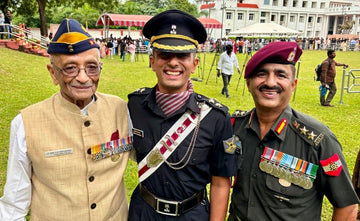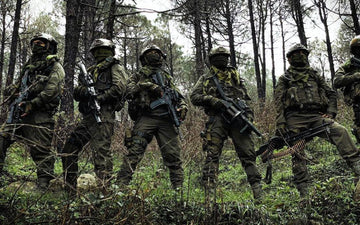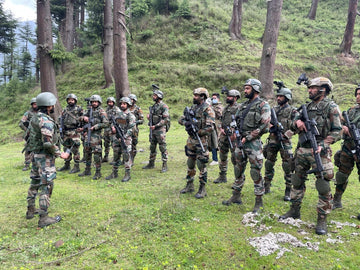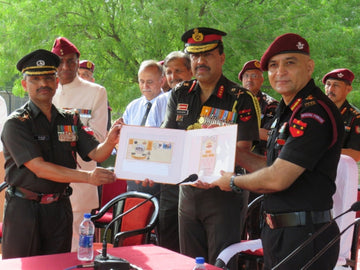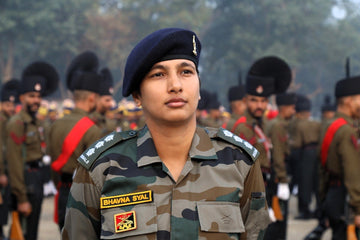To become a Lieutenant in the Indian Army is not just an aspiration; it is a call to serve the nation with valor and commitment. This prestigious rank is a stepping stone for individuals who dream of a life guided by discipline, leadership, and determination. The journey to this esteemed position involves a rigorous selection process, ensuring that only the most qualified candidates don the uniform. In this article, we will walk you through the eligibility criteria, selection process, training institutions, and various entry schemes involved in becoming a Lieutenant in the Indian Army.
Historical Context
The Indian Army, one of the oldest and largest standing armies in the world, traces its origins back to the 18th century. Over the years, it has played a pivotal role in shaping India's military history, responding to various challenges, and ensuring the nation's sovereignty. The rank of Lieutenant has been a crucial element in this evolution, serving as a vital leadership role that coordinates and guides junior officers and troops. The pathway to this rank has historically embodied a blend of courage, academic excellence, and physical fitness, firmly establishing a reputation for those who wear the uniform.
Eligibility Criteria
Before embarking on the journey to becoming a Lieutenant, candidates must meet specific eligibility criteria that serve as a foundation for the selection process.
Age Limit
- General Requirement: Aspirants must be between 19 to 26 years old.
- Relaxations: Certain entry schemes, particularly those requiring specialized skills (like technical backgrounds), may permit age extensions for applicants.
Nationality
Candidates must be citizens of India, emphasizing the importance of national service and commitment to the country.
Educational Qualifications
- General Requirement: A bachelor’s degree from a recognized university is essential for most entry schemes.
- Technical Entry Scheme (TES): Requires candidates to have completed 10+2 with a minimum of 70% in Physics, Chemistry, and Mathematics. This emphasizes the Army's focus on candidates with strong technical and analytical abilities.
Marital Status
Candidates must be unmarried for most entry modes, ensuring that they can devote full attention to their responsibilities as military officers.
Physical Fitness
-
Minimum Height:
- 157.5 cm for males
- 152 cm for females
- Weight: Must be proportionate according to age and height.
- Vision Criteria: Candidates should have 6/6 vision in one eye and 6/9 in the other, with corrections permissible to 6/6.
Selection Process
The journey to becoming a Lieutenant involves a multi-faceted selection process designed to assess candidates' intellectual and physical capabilities.
Written Examination
Candidates can undertake one of two significant examinations:
- National Defence Academy (NDA): Candidates opt for this route after completing their 10+2 education.
- Combined Defence Services (CDS): This is targeted at graduates and tests knowledge in Mathematics, English, General Knowledge, and Logical Reasoning.
Direct SSB Interview Entries
For certain candidates, there are alternative pathways that bypass the written examinations. These pathways include:
- Technical Entry Scheme (TES)
- Technical Graduate Course (TGC)
- Short Service Commission – Technical (SSC Tech)
- NCC Special Entry
- Judge Advocate General Branch (JAG) Entry
Candidates under these entry schemes receive direct invitations to participate in the Services Selection Board (SSB) Interview.
SSB Interview
The SSB interview is a grueling five-day process that includes:
- Screening Test: Assessing intelligence and picture perception through initial tasks.
- Psychological Tests: Evaluating personality traits, decision-making, and adaptability.
- Group Testing Officer (GTO) Tasks: Involving teamwork and leadership skills in various exercises.
- Personal Interview: Assessing communication, readiness for officer responsibilities, and psychological aptitude.
- Conference: The final stage where the selection board makes comprehensive evaluations based on the entire process.
Medical Examination
Candidates who successfully navigate the SSB interview undergo a rigorous medical examination to ensure both physical and mental fitness, essential for the demanding role of a lieutenant in service.
Merit List and Final Selection
Following the assessments, a merit list is compiled based on the performance in the written examination (if applicable), SSB interview, and medical examination. Candidates successfully securing positions on this merit list are then considered for final selection and subsequently sent for training.
Training Institutions
Once selected, candidates receive rigorous training at one of the following esteemed institutions:
- National Defence Academy (NDA): Located in Khadakwasla, it trains cadets from the Army, Navy, and Air Force.
- Indian Military Academy (IMA): Located in Dehradun, it is dedicated to producing Army officers.
- Officers' Training Academy (OTA): Primarily for preparing Short Service Commission officers.
These institutions focus on physical training, leadership development, tactical skills, and strategic thinking, ensuring candidates are equipped for the responsibilities that come with being a Lieutenant.
Entry Schemes
The Indian Army offers multiple pathways for individuals aspiring to become Lieutenants. Each scheme caters to different educational backgrounds and timelines. Below are the prominent entry schemes:
- UPSC Exam and NDA: For candidates completing their class 12th education.
- Combined Defence Services Exam (CDS): Ideal for graduates aspiring to join the Army.
- Technical Entry Scheme (TES): Catering to candidates with a 10+2 background in PCM.
- University Entry Scheme: For university students, primarily those in their pre-final year.
- Technical Graduate Course (TGC): Exclusively for engineering graduates.
- Short Service Commission – Technical (SSC Tech): For technical graduates in specified fields.
- NCC Special Entry: A program for cadets who excel in National Cadet Corps (NCC).
- JAG Entry: Targeted towards law graduates, focusing on those who wish to pursue a legal career in the Defence Services.
Case Studies and Real-World Applications
To understand the significance of the role of a Lieutenant, consider the real-world example of Lieutenant Colonel Arvind S. Sood, who led his platoon during the Kargil War in 1999. Lieutenant Colonel Sood's exemplary leadership and tactical excellence guided his team through challenging terrains, where they played a crucial role in reclaiming strategic points from enemy forces. His actions not only demonstrate the physical and intellectual demands the position entails but also underscore the honor and responsibility associated with serving as a Lieutenant in the Indian Army.
Statistical Data and Research Insights
Data suggest that the Indian Army is one of the largest in the world, with over 1.4 million active personnel. The rigorous standards for entry and selection ensure that only highly competent individuals ascend to positions of responsibility. The estimated number of candidates who appear for the NDA exam exceeds 2 lakh each year, with approximately 8,000 being recommended for training across various branches.
Challenges and Solutions
The journey to becoming a Lieutenant is fraught with challenges, including intense competition and multifaceted exams. Candidates often face pressure during the preparation for written exams and SSB interviews. However, the following strategies can be employed:
- Structured Study Plans: Preparing a rigid and structured study plan to ensure coverage of all subjects pertinent to the exams.
- Physical Fitness Regimes: Incorporating consistent physical training, including cardiovascular fitness and strength-building exercises.
- Mock Interviews: Engaging in practice SSB interviews can be invaluable in easing the anxiety associated with the actual interview process.
- Peer Support Groups: Forming or joining study groups with fellow aspirants can foster motivation and provide diverse perspectives on problem-solving.
Future Trends and Predictions
As geopolitical scenarios evolve, the Indian Army's role will likely expand, creating a need for more qualified officers. Emerging technological fields such as cyber warfare and artificial intelligence will call for Lieutenants with specialized training in these areas. The Army is beginning to incorporate such disciplines into training programs, preparing future officers to navigate complex challenges.
Conclusion
Becoming a Lieutenant in the Indian Army is a journey marked by intense commitment, resilience, and personal growth. Through a combination of rigorous examinations, comprehensive training, and a deep sense of patriotism, candidates can achieve this prestigious rank. For those aspiring to wear the uniform, aligning with a well-structured preparation strategy and embracing the challenges head-on will lay the foundation for a fulfilling and honorable career in the defence of the nation. If you are ready to embark on this transformative path, resources such as SSBCrack and SSBCrackExams offer valuable study materials, online courses, and eBooks to guide you through every step of the process. The honor of serving as a Lieutenant awaits, and your journey begins now.

